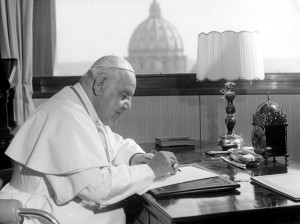VATICAN CITY – Pope John XXIII, who was proclaimed a saint with John Paul II on Sunday, surprised many by leading the Catholic Church to more open relations with the world.
When the man nicknamed “Good Pope John” became head of the Catholic Church on October 28, 1958 at the age of 77, many thought he would be a simple caretaker.
He had a determined character, however, and led a process of modernization of the Church and closer ties with Judaism, inviting comparisons from Vatican watchers to the current reform-minded Pope Francis.
“There is a spiritual and ideological continuity between John XXIII and Francis,” said Angelo Pansa, a historian specializing in John XXIII’s reign.
Less than three months after being elected, John XXIII announced preparations for the Second Vatican Council, a global gathering of Catholic bishops, which opened in October 1962 and proved to be revolutionary.
Unnerving Vatican conservatives, he reached out in a famous address to crowds in St Peter’s Square at the start of the Council which spoke of his desire to bridge the gap between the Church and the faithful.
“All the world is represented here tonight, even the moon hastens close to watch this spectacle. When you head home, hug and kiss your children and tell them: ‘This is the hug and kiss of the pope’,” he said.
Peacemaker
He was the first pope to leave the confines of the Vatican to visit parishes and hospitals in Rome — a tradition that has been followed by his successors.
Pope John did not live to see the end of the Council, dying on June 3, 1963 of complications linked to stomach cancer less than two months after he wrote the papal encyclical, Pacem in Terris (Peace on Earth).
It was addressed “to all men of good will” and not only Catholics, and was in part a reaction to the prevailing political situation in the midst of the Cold War.
Time Magazine named him Man of the Year in 1962, hailing him as a peacemaker after his address during the Cuban missile crisis helped defuse tensions.
Pansa said “he wanted to leave a door open to the Soviet Union, seen in the West as the Empire of Evil.”
The historian pointed out that John XXIII donated rosaries to the children of Soviet leader Nikita Khrushchev and US president John F. Kennedy — a gesture “to unite the White House and the Kremlin”.
On a more personal level, John XXIII had a healthy sense of humor. Once asked by a reporter how many people worked in the Vatican, he replied: “About half.”
‘A smiling face’
The Vatican Council led to important modernizing reforms within the Church, including the possibility of celebrating mass in languages other than Latin.
“I wish to open the Church’s window so that we may see what is happening outside and so the world may see what is happening within,” the pope wrote.
His former private secretary, Cardinal Loris Capovilla, said his success lay “in a traditional but dynamic imprint, in the apparent paradox between strict conservatism and evangelical openness”.
The man who would be pope was born Angelo Giuseppe Roncalli in Sotto il Monte, northern Italy on November 25, 1881.
Ordained in 1904, he was called to Rome in 1921 to head missionary activities in Italy.
Appointed bishop four years later, he began a diplomatic career that took him to Bulgaria, Turkey and France.
He was credited with saving thousands of Jews during World War II, including by giving Hungarian Jews baptismal certificates.
A document on file at the Yad Vashem Holocaust memorial cites the future pope as being “among the most sensitive to the Jewish tragedy and most vigorous in rescue efforts”.
In 1953 he became a cardinal and patriarch of Venice, and was elected as pope five years later following the death of Pius XII.
As pope he worked hard to improve relations between the Catholic Church and other Christian faiths, notably Anglicans, Eastern Orthodox and Protestants.
Pope John was beatified in August 2000, based on the healing of an Italian nun, sister Caterina Capitani, which was declared a miracle after a medical commission determined there was no scientific explanation for the event.
Capitani had undergone an operation to remove a cancerous tumor in her stomach and was not expected to live, but appeared to suddenly recover after addressing her prayers to pope John.
He was beatified by then pope John Paul II, who pursued John’s outreach to Jews with a historic visit to the Wailing Wall in Jerusalem in March 2000.
John Paul II said at the time of John’s beatification that he had shown “a singular goodness of soul” and “left in the memory of all the image of a smiling face and two arms open to welcome the entire world.”
RELATED STORIES
Pope Francis declares new saints John Paul II, John XXIII
St. Peter’s overflows for historic day of 4 popes
Filipinos celebrate ahead of canonization of John Paul II and John XXIII
